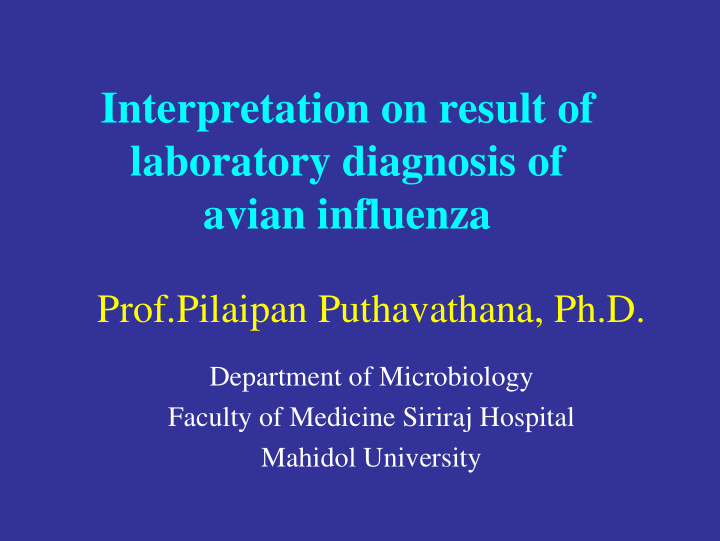



Interpretation on result of laboratory diagnosis of avian influenza Prof.Pilaipan Puthavathana, Ph.D. Department of Microbiology Faculty of Medicine Siriraj Hospital Mahidol University
Case definition of AI case Thai Bureau of Epidemiology, 1 June 2006 AI suspected case Patients who have fever > 38C plus any of the followings : myalgia, cough, abnormal breath (dyspnea or respiratory distress) or suspected of pneumonia and History of direct exposure to dead or sick poultry within 7 days before onset of symptom, or, closely providing health care to patients with pneumonia 10 days before and No clinical specimen available for lab investigation
AI probable case Patients who meet the definition of suspected cases and developed signs and symptoms of, or died from acute respiratory failure
AI confirmed cases Patient who meet the definition of suspected cases and has a final standard laboratory confirmation of fluA/H5 through at least one of the following methods A. Single RT-PCR using two primer/probe sets or using specimens collected from at least two different location or using at least two specimens collected at different period B. Viral culture C. NT test ( four fold antibody increase in paired blood)
H and N classification for FluA H1, 2, 3........16 N1, 2, 3.........9
H and N classification • All kinds of H and N are present in aquatic birds • Only H1,H2 and H3 ; and N1 and N2 are found in most human population, except reports of the emerging of H5N1, H7N7 and H9N2 viruses
Fields Virology. Third edition. Lippincott Williams and Wilkins, Philadelphia
Genome segments of influenza viruses Influenza A RNA Encoded protein segment Name Function 1 PB2 polymerase 2 PB1 polymerase 3 PA polymerase 4 HA,H hemagglutinin 5 NP nucleoprotein 6 NA, N neuraminidase 7 M1, M2 matrix (membrane) proteins 8 NS1,NS2 Nonstructural proteins
Clinical samples NP wash/aspirate, NP swab, throat swab, sputum, endotraheal swab/aspirate, tissues •Antigen detection •Virus isolation •Molecular diagnosis Paired blood for antibody
Molecular diagnosis • RT-PCR, nucleotide sequencing • M gene is used to design universal primers for all flu A • H and N genes for subtyping • House keeping gene to check for quantity of RNA in clinical samples
663 bp Multiplex PCR for H1&H3 100 bp Marker Influenza A (H3) Influenza B Patient Blank 100 bp Marker PCR for H5 Influenza A (H3) Influenza B Siriraj Virology Lab Patient Blank 591 bp
BLAST of H nucleotide sequence (606 nt) from a patient Identities H5N1 : AY075030 96% H5N1 : AY075027 96% H5N1 : AF098545 96% H5N1 : AF216737 96% H5N1 : AF216721 96% H5N1 : AY075033 96% Siriraj Virology Lab
Failure to get promising result • Inadequate specimen • Lab techniques involve many steps that might prone to an error result • Viral gene change
Virus isolation technique • It is the gold standard method • It requires BSL 3 facilities • Cell culture : MDCK, LLC MK2 • Chick embryonated eggs
• Virus isolation needs molecular techniques (RT-PCR, nucleotide sequencing) for type and subtype identification • Monoclonal antibody can be used in the identification
Siriraj Virology Lab LLC-MK2
Siriraj Virology Lab Identification of flu A isolate in cell culture by IFA
Siriraj Virology Lab
Siriraj Virology Lab Hemagglutination test +
Antibody detection • Paired blood (2-3 weeks apart) for a four- folded increase in antibody titer • If single blood is obtained, what is the significant titer ? • Micro-neutralization (Micro-NT) test is recommended as hemagglutination- inhibition (HI) test is less specific
What is the significant antibody titer ? : I What is the meaning for possessing H5 NT antibody Vaccination with H5 antibody Natural infection Exposure to viral antigen (dead viruses) in the environment
What is the significant antibody titer ? : II • Some patients did not develop H5 antibody when they died. • Cross reactivity with other H subtype in old age • Mild case can develop a four folded rise in Ab titer
Significant antibody titers • U.S. CDC. for H5N1 Ab : > 80 • Japan for H5N1 Ab : > 10 • Europe for H7 Ab : > 20 Confirmatory test by Western Blot assay
Immunofluorescence test Rapid test Antigen testing
Ag detection • Quick tests are less sensitive and less specific • Quick test require specific solution for specimen collection • Immunofluorescence(IF) test is subjective, but it can be used to test for other respiratory viruses
Adeno RSV Flu B Flu A Respiratory viruses PF1 PF2 PF3 Indirect immunofluorescence test for respiratory viruses
PF3 RSV PF3
Adeno FluB
• GOLDEN RULE : Not process avian, swine and human samples in the same lab • More than one standard techniques will give the precise diagnosis • Network for proficiency test may be needed
Risk groups of microorganisms Risk gr.1 : Low individual risk and low community risk e.g., B. subtilis, E.coli Risk gr.2 : Moderate individual risk and limited community risk e.g., S typhi , HBV , M.tuberculosis Risk gr.3 : High individual risk and low community risk e.g., Brucella, Lassa fever virus, SARSCoV, bird flu, HIV culture Risk gr.4 : High individual risk and high community risk e.g., Ebola-Marburg virus, foot and mouth disease virus, Nipah virus
Lab classification • Biosafety Level 1 : teaching lab • Biosafety Level 2 : clinical, diagnostic lab working with moderate risk agents • Biosafety Level 3 : for indigenous or exotic agents with a potential for respiratory transmission • Biosafety Level 4 : for dangerous and exotic agents which pose a life- threatening disease, no vaccine and therapy available
Recommend
More recommend